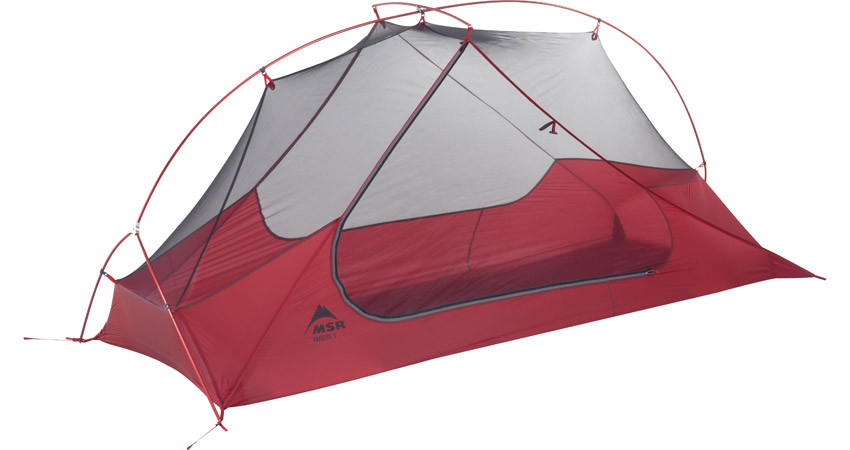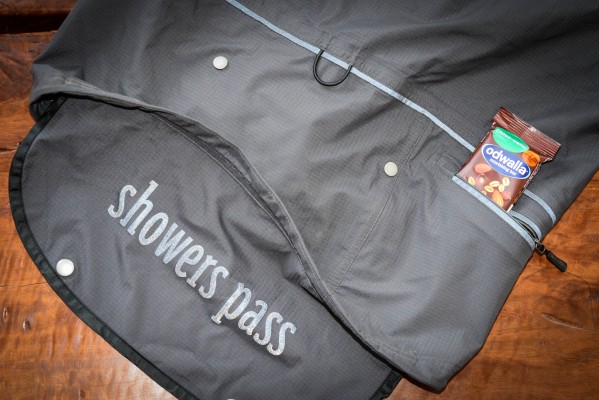
MSR is probably best known for their stoves and water filters, but the company makes a full array of tents and shelters, too. The FreeLite 1 tested here is the lightest freestanding tent MSR offers. It sells for a considerable $370 (plus an extra $50 if you want the matching footprint), but ultra-lightweight gear is rarely inexpensive. I took the FreeLite on a handful of trips over the summer and fall to see how it fared in the wild.
Specs
The FreeLite 1 is a double-wall tent with a mostly mesh body and a waterproof rainfly. To keep weight to a minimum, there’s very little nylon used for the body of the tent. For instance, the entire door is mesh, as well as all but the lower third of the walls. There’s only one single door, on the right side of the tent–again, to keep weight down.

When erected, the tent measures 86″ long by 30″ wide, and is 36″ tall at its highest point. The vestibule created by the rainfly adds another 24″ to the door side of the tent. At 6′ tall I had plenty of room for my head and feet despite the tent’s taper, and the interior was high enough that I could sit up comfortably.

The entire setup — including the addition of the footprint — weighed in at 1,244g / 2.74lbs. on my scale. Ditching the stuff sacks for the poles, stakes, and the tent itself can shave a good chunk of that off. You’ll need to be extra careful when packing it if you go this route, though. If weather permits, ditch the tent body and rock out with just the rainfly and footprint. I didn’t personally try this, but MSR claims this “Fast & Light” configuration weighs 740g / 1.63lbs.
On the Trail

The FreeLite takes up a surprisingly small amount of space. I carried it in my Bike Bag Dude handlebar roll, but there was still room left over for my sleeping pad, a light rain jacket, arm warmers, and knee warmers. It’s pretty simple to set up, although I’ll admit I looked at the instructions on the first run. MSR printed the instructions directly on one of the stuff sacks, so they’ll always be there should you need them. After a few tries, I could have the tent totally set up in less than seven minutes. I even did it in the dark a couple times without trouble.

Compared to the competing Big Agnes Fly Creek HV UL1 — which I also used this summer — the FreeLite was a bit more difficult to set up, but just marginally so. However, when it came to usability and functionality, the FreeLite beat the pants off the Fly Creek. The biggest difference between the two is in the location of the door. On the Fly Creek, the door is at your head, which made it a pain in the ass to get in and out of, particularly for late night pee breaks. The FreeLite’s door is on the right side of the tent and is about the same size as it would be on a larger tent.

I also felt like the FreeLite had more usable vestibule space. It rained at night during the Cohutta Cat in November, but the large vestibule helped me keep my shoes and bags from getting soaked. On that subject, the FreeLite kept me dry despite consistent rain through the night. When it wasn’t raining, I peeled off the rainfly to gaze at the stars through the entirely mesh ceiling. This isn’t a tent you’ll overheat in, that’s for sure.
Things to Improve

As much as I like the MSR FreeLite, there is room for improvement. First up, can all tent manufacturers please just include the dang footprint with the tent?! Especially with an uber-light tent like this one, the footprint is a requirement to boost durability.
The biggest improvement to the design would be to change the pole configuration slightly. In its current layout, the pole folds out so that one end has a “V” shape and there’s a crossbar in the middle to spread out the rainfly. The other end that connects to the toe box of the tent is a single pole. This works pretty well as long as you stake out the toe box tightly — and as long as the ground cooperates — but using another “V” would negate the need to stake so tightly. On a couple occasions, one of the stakes pulled out of the ground, and that corner of the tent would flop inward. Not a huge deal, unless it’s raining.
I’d make another change to the poles as well. The tips of the poles are made from plastic, but I’d much rather see aluminum. When MSR shipped the tent, one of the tips broke in transit. Since there’s just one pole, a broken tip means you can’t set up the tent. Luckily I discovered this before heading into the woods, otherwise it could have been disastrous. Using aluminum would probably add a handful of grams to the tent, but the tradeoff in durability and the boost in peace of mind would make up for it. Every time I set up or took down the FreeLite, I was nervous about banging the tips into something and breaking one.

A couple other small things to address: One, the toggle that holds the rainfly door open is too loose, hard to operate, and is poorly-located. As it sits, the door easily flops out of the toggle, defeating its purpose. Two, there needs to be a longer tab on the left side of the rainfly to stake it out. There’s just a tiny tab there now, and honestly I’m not exactly sure what to do with it. It’s too high to stake down as it sits, but you really need to stake out that side of the rainfly to keep it off the body of the tent. Finally — and I’m getting really nit-picky here — I’d like to see an overhead mesh pocket inside the tent. A single mesh pocket sits at the head of the tent, but that’s it for internal storage.
Finish Line
In spite of the flaws I found, the MSR FreeLite 1 is still an excellent product. It’s not only light, but it packs quite compactly, making it a good option for bikepackers. Most importantly, the FreeLite performed its most basic function — shelter — perfectly. As a one-person tent focused on cutting weight, it was notably roomy, easy to get in and out of, and simple to set up.
- Available at Amazon
Thanks to MSR for providing the FreeLite 1 for review.



















